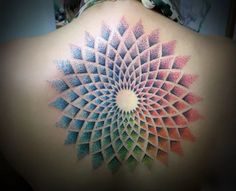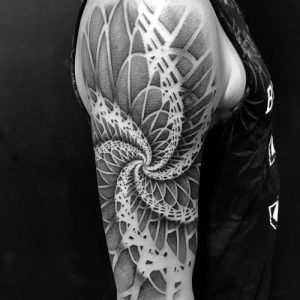
Mandala tattoos have gained immense popularity in the world of body art, captivating people with their intricate patterns and symbolic significance.
These mesmerizing tattoos, originating from ancient spiritual practices, hold a profound story within their circular designs.
In this article, we delve into the captivating world of mandala tattoos, exploring their history, symbolism, and the personal stories that individuals etch on their skin.
The term “mandala” finds its roots in Sanskrit, meaning “circle” or “discoid object.”

Mandalas have been used in various cultures throughout history as a spiritual and ritualistic symbol, representing unity, wholeness, and the interconnectedness of the universe.
The intricate patterns and geometric shapes within mandalas create a harmonious balance, reflecting the cyclical nature of life and the journey toward self-realization.
Mandala tattoos have found their place in contemporary body art as individuals seek to express their inner journeys, beliefs, and personal transformations.
The process of getting a mandala tattoo is deeply personal, often involving a collaborative effort between the tattoo artist and the client.
The design is meticulously crafted, taking into account the individual’s intentions, desires, and the symbology they wish to incorporate.

One of the key aspects of mandala tattoos is the symbolism associated with different elements within the design.
Each element, such as geometric shapes, flowers, animals, or spiritual symbols, carries its own significance.
For example, circles within the mandala represent unity and the eternal cycle of life, while triangles symbolize balance and transformation.
Lotus flowers may represent purity and enlightenment, while elephants symbolize strength and wisdom.
The choice of colors in mandala tattoos also holds meaning.
Vibrant and bold colors can represent energy, passion, and vitality, while softer pastel hues evoke a sense of tranquility and serenity.
Individuals often personalize their mandala tattoos by incorporating meaningful symbols or objects that hold significance in their lives, such as birthstones, spiritual symbols, or elements from nature.

Beyond the visual appeal, mandala tattoos hold a deep emotional and spiritual significance for many individuals.
They can serve as a visual reminder of personal growth, overcoming obstacles, or finding inner peace.
Mandala tattoos are often seen as a transformative and empowering symbol, encouraging individuals to embrace their uniqueness, seek balance, and connect with their higher selves.
Mandala tattoos have become more than just beautiful works of art on the skin; they are profound expressions of personal stories, spiritual beliefs, and inner journeys.
As individuals choose to etch these mesmerizing designs on their bodies, they carry with them a piece of history, symbolism, and personal growth.

Mandala tattoos serve as a constant reminder to embrace the cyclical nature of life, find harmony within oneself, and celebrate the interconnectedness of all things.
With each stroke of ink, a unique and captivating story unfolds, revealing the mystic beauty of mandala tattoos.






